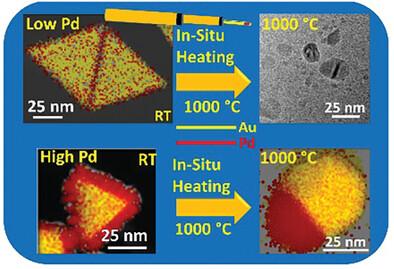Direct Visualization of Temperature-Induced Phase Separation of Completely Miscible Au─Pd Alloy by In Situ TEM
IF 13
2区 材料科学
Q1 CHEMISTRY, MULTIDISCIPLINARY
引用次数: 0
Abstract
In situ transmission electron microscopy (TEM) studies reveal key insights into the structural and chemical evolution of nanoparticles (NPs) under external stimuli like heating and biasing, which is critical for evaluating their suitability in chemical reactions and their tendency toward forming novel NP systems. In this study, starting from a core@shell Au nanotriangle (AuNT)@Pd nanostructure, the formation of a phase-separated bi-metallic Au─Pd NP system at high temperature is reported, despite the fact that Au and Pd are miscible in the entire composition and temperature range. In situ TEM heating of bare AuNT@Pd core@shell structures up to 1000 °C is performed. Between 400 and 800 °C, an initial alloy formation is observed. Notably, higher initial loading of Pd increases the melting temperature of the bi-metallic system. However, the most important observation is the separation of the nanostructure into Au and Pd phases at temperatures above 850 °C for high Pd doping. The extent of Pd separation depends on the amount of initial Pd loading. A Janus Au─Pd nanostructure is formed at the end of the thermal treatments at 1000 °C. The phase-separated NP is observed to be highly stable and could be clearly beneficial for various applications, particularly in catalytic processes.

求助全文
约1分钟内获得全文
求助全文
来源期刊

Small
工程技术-材料科学:综合
CiteScore
17.70
自引率
3.80%
发文量
1830
审稿时长
2.1 months
期刊介绍:
Small serves as an exceptional platform for both experimental and theoretical studies in fundamental and applied interdisciplinary research at the nano- and microscale. The journal offers a compelling mix of peer-reviewed Research Articles, Reviews, Perspectives, and Comments.
With a remarkable 2022 Journal Impact Factor of 13.3 (Journal Citation Reports from Clarivate Analytics, 2023), Small remains among the top multidisciplinary journals, covering a wide range of topics at the interface of materials science, chemistry, physics, engineering, medicine, and biology.
Small's readership includes biochemists, biologists, biomedical scientists, chemists, engineers, information technologists, materials scientists, physicists, and theoreticians alike.
 求助内容:
求助内容: 应助结果提醒方式:
应助结果提醒方式:


